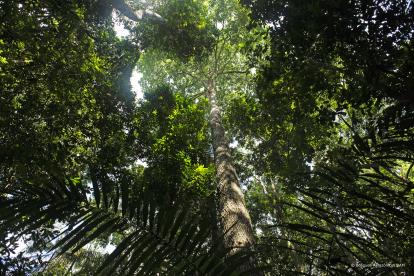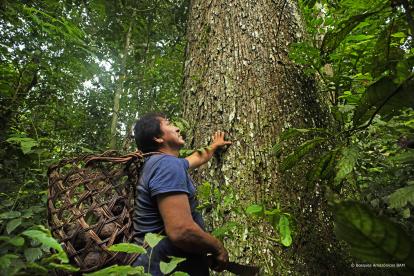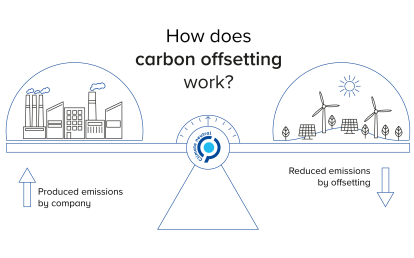
How do forest protection projects work?
Explained using the example of our carbon offset project in Tambopata, Perú
More than 100 countries have committed to stop the destruction of forests and other land-based ecosystems by 2030 at the COP26, the UN Climate Change Conference. The signatory countries, including the entire EU along with Germany, represent 85 percent of the world's forest coverage. The pledge includes more than $19 billion in public and private funding.
The commitment, known as the Leader´s Declaration on Forests and Land Use, also aims to contribute to climate protection through more forest protection and greater protection of biodiversity. After all, forests absorb about one-third of the CO2 emissions emitted by humans each year.
But forest coverage is in danger: The Food and Agriculture Organization FAO estimates that global wood consumption will increase by 50 percent by 2050. This continued increase in demand is putting enormous pressure on existing forests. The COP26 commitment's 2030 target is therefore very late and allows for another decade of forest destruction and dwindling biodiversity. Support for forest reforestation, forest redevelopment and forest protection projects is now more necessary than ever.

A key mechanism for protecting forests is the REDD+ mechanism (Reducing Emissions from Deforestation and Degradation) created by the United Nations in 2008. The concept is to involve local people in forest protection and reward them for their efforts to preserve the forest.
The older trees become, the more greenhouse gas emissions they can absorb - and the more valuable such a forest area is in protecting against climate change. REDD+ projects contribute to the avoidance of CO2 emissions associated with deforestation. A tree saved from logging acquires a higher value than if it were cut down and sold.
The CO2 emissions avoided in the process can be claimed as climate protection certificates, so-called carbon credits. Marketing them makes forests more economically attractive than other land uses. The revenues from the sale of carbon credits are used to protect the forest, to manage its resources sustainably, and above all to create opportunities for the local population, such as new jobs, education, and improved health conditions. Thus, the REDD+ mechanism enables the community to actively participate in climate protection and local social development.
Many of the carbon offset projects we offer that deal with forest protection work with the REDD+ mechanism. This is also the case for our forest protection project in Tambopata, Perú.

Carbon offset projects and the saving of greenhouse gases
In order to be considered a carbon offset project and to be certified in the official registers as an effective measure to demonstrably save greenhouse gases, each project must meet the following four criteria: Additionality, exclusion of double counting, permanence, and regular independent audits. These requirements are laid down in the world's leading best-practice regulations for forest protection projects of the Verified Carbon Standard (VCS), which is administered by the independent organization VERRA.
Carbon offset projects according to the VCS are always CO2 reduction projects in the areas of forest protection, (re)afforestation, energy efficiency or renewable energy development that are validated and regularly verified by independent auditors and that reduce, avoid or remove additional greenhouse gas emissions from the atmosphere. In this way, they contribute to the mitigation of climate change. By supporting these certified projects, companies can enhance their emissions reduction strategy, thereby promoting sustainable progress in developing countries and offsetting their own residual emissions elsewhere.

Our REDD+ carbon offset project in Tambopata, Peru
In Tambopata, in the southeastern part of the Peruvian region of Madre de Dios, ClimatePartner is committed to preserving the Amazon rainforest in close cooperation with the local project partner BAM through a variety of project activities. The project helps Brazil nut farmers to officially declare and protect their land (concessions) while increasing their yields from the Brazil nut harvest. In 2009, the project was initiated. In the same year, the local project partners agreed to cooperate with the Federation of Brazil Nut Producers of Madre de Dios (FEPROCAMD). Together they developed the REDD+ forest conservation project, which was certified according to VCS.
Tambopata without the carbon offset project - the baseline scenario
Prior to the launch of the carbon offset project in 2009, several factors led to increasing deforestation in the region. These included logging to obtain farm and range land and improved access to the region through the construction of the Interoceanic Highway (IOH). In particular, due to the highway and the associated resettlement of people, there was a demonstrable risk that rainforest would be increasingly deforested (baseline scenario).
Positive developments thanks to project activities
At the very beginning of the project, starting in 2010, the Brazil nut farmers received training on cultivation and harvesting techniques, economic foundation building, and access to agricultural machinery and tools, with the goal of protecting the rainforest.
Most importantly, it created for the first time the basis to exercise their land use rights for nut cultivation in their concessions. One of the project activities includes the official demarcation of the concession areas in order to define and properly respect the exact boundaries of the concessions of each partner. Even though land use concessions have existed since 2000, their physical delineation on the ground, and thus the protection and management of natural resources in a tropical rainforest, is a challenge that was only achieved through the project activity.
The following measures were implemented:
- Capacity Building Workshops: The project provides training workshops to improve concessionaires' knowledge of how to sustainably manage and protect their forests, and to create further opportunities for them and their families.
- Monitoring, control and surveillance system: the Tambopata project has a system aimed at identifying, reporting and controlling deforestation hazards. The system includes continuous technical and legal advice to concessionaires from project staff (professionals who attend to the needs of concessionaires on a full-time basis).
- Organizational strengthening: FEPROCAMD received permanent financial and technical support through the project to realize its mission and vision of representing the interests of Brazil nut farmers and increasing the value added by Brazil nuts in the region.
- Implementation of a scientific program: this is used to continuously assess the ecological capital of the area and to monitor the impact of conservation measures on biodiversity.
- Concession delineation through geographic information systems (GIS) and markers that facilitate enforcement of concession boundaries and monitoring of logging caps.
- Preparation of land management plans for each concession by georeferencing all Brazil nut trees within the concession, construction and maintenance of trails, preparation of water management plans.
- Submission of management plans to environmental authorities to obtain official approval for the sustainable use of Brazil nuts.
Since 2020, in addition to the above-mentioned non-financial benefits and advantages, Brazil nut farmers also receive direct financial support, which comes from the sale of climate protection certificates. More than 400 concessionaires (source: BAM) are now benefiting from activities under the REDD+ project.
Do you want more information?
- Read our fact check on the Tambopata project
- Our press release from 6.12.
- Our press release from 9.12.